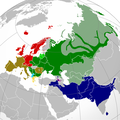Fail:Indo-European branches map.png

Selle eelvaate suurus: 599 × 600 pikslit. Teised eraldusvõimed: 240 × 240 pikslit | 479 × 480 pikslit | 767 × 768 pikslit | 1023 × 1024 pikslit | 2045 × 2048 pikslit | 2934 × 2938 pikslit.
Algfail (2934 × 2938 pikslit, faili suurus: 2,16 MB, MIME tüüp: image/png)
Faili ajalugu
Klõpsa kuupäeva ja kellaaega, et näha sel ajahetkel kasutusel olnud failiversiooni.
| Kuupäev/kellaaeg | Pisipilt | Mõõtmed | Kasutaja | Kommentaar | |
|---|---|---|---|---|---|
| viimane | 26. september 2022, kell 06:43 |  | 2934 × 2938 (2,16 MB) | Alexikoua | minor fixes |
| 30. märts 2022, kell 18:58 |  | 2934 × 2938 (1,74 MB) | Whoop whoop pull up | Whoops, wrong file! | |
| 30. märts 2022, kell 18:37 |  | 2048 × 2048 (980 KB) | Whoop whoop pull up | Misc fixes (Russian minority in Svalbard & Israel, Slovenian in SE Carinthia, Greek in N Epirus, Aromanians/Megleno-Romanians, Swedish essentially extinct in Estonia, etc. | |
| 22. detsember 2021, kell 12:37 |  | 2934 × 2938 (1,74 MB) | Ahmet Q. | Reverted to version as of 19:55, 23 August 2021 (UTC)seek consensus for your changes | |
| 25. november 2021, kell 23:40 |  | 2934 × 2938 (2,16 MB) | Alexikoua | rv elimination of Greek minority in Albania | |
| 23. august 2021, kell 22:55 |  | 2934 × 2938 (1,74 MB) | Ahmet Q. | Rv false edit summary. Overrepresentation of Greeks in Turkey, Albania and Ukraine. Unexplained removal of Romanian in Serbia. Overall deterioration of the original file. Seek consensus for your changes. | |
| 7. august 2021, kell 19:16 |  | 2934 × 2938 (2,16 MB) | Demetrios1993 | Addition of Arbereshe linguistic minority in Sicily. Addition of Serbian, Bosnian, and Gorani linguistic minorities in Kosovo. Addition of Greek linguistic minorities in Italy, Albania, Turkey, and Ukraine. Including some other minor corrections. | |
| 19. november 2020, kell 20:00 |  | 2934 × 2938 (1,74 MB) | Golden | update Armenian | |
| 31. märts 2018, kell 21:42 |  | 1479 × 1479 (574 KB) | Maphobbyist | Removed area that exactly corresponds to the non-Indo European Lezgi linguistic area. | |
| 7. september 2016, kell 00:37 |  | 1479 × 1479 (620 KB) | Rob984 | Georgia and Azerbaijan aren't majority multilingual. Older generations speak Russian from the Soviet era but now English is taught mainly in place of Russian. More people speak English in Finland, yet that isn't coloured. Also corrections to Celtic are... |
Faili kasutus
Seda faili kasutab järgmine lehekülg:
Globaalne failikasutus
Järgmised muud vikid kasutavad seda faili:
- Faili kasutus vikis ast.wikipedia.org
- Faili kasutus vikis ban.wikipedia.org
- Faili kasutus vikis be-tarask.wikipedia.org
- Faili kasutus vikis be.wikipedia.org
- Faili kasutus vikis bg.wikipedia.org
- Faili kasutus vikis cs.wikipedia.org
- Faili kasutus vikis da.wikipedia.org
- Faili kasutus vikis de.wikipedia.org
- Faili kasutus vikis en.wikipedia.org
- Faili kasutus vikis en.wikiversity.org
- Faili kasutus vikis es.wikipedia.org
- Faili kasutus vikis eu.wikipedia.org
- Faili kasutus vikis fa.wikipedia.org
- Faili kasutus vikis fi.wikipedia.org
- Faili kasutus vikis frr.wikipedia.org
- Faili kasutus vikis fr.wikipedia.org
- Faili kasutus vikis gl.wikipedia.org
- Faili kasutus vikis gu.wikipedia.org
- Faili kasutus vikis gv.wikipedia.org
- Faili kasutus vikis hak.wikipedia.org
- Faili kasutus vikis he.wikipedia.org
- Faili kasutus vikis hy.wikipedia.org
- Faili kasutus vikis hyw.wikipedia.org
- Faili kasutus vikis ilo.wikipedia.org
- Faili kasutus vikis incubator.wikimedia.org
- Faili kasutus vikis io.wikipedia.org
- Faili kasutus vikis it.wikipedia.org
Vaata selle faili globaalset kasutust.


